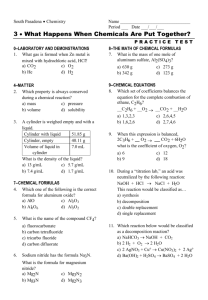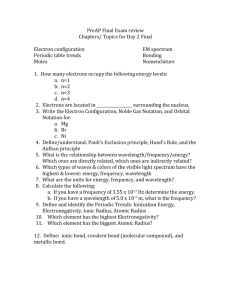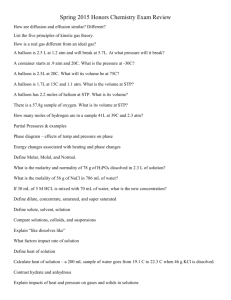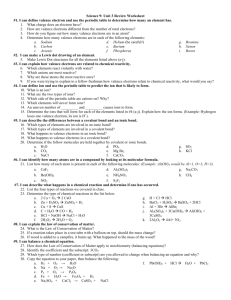PRACTICE TEST for EXAM 4
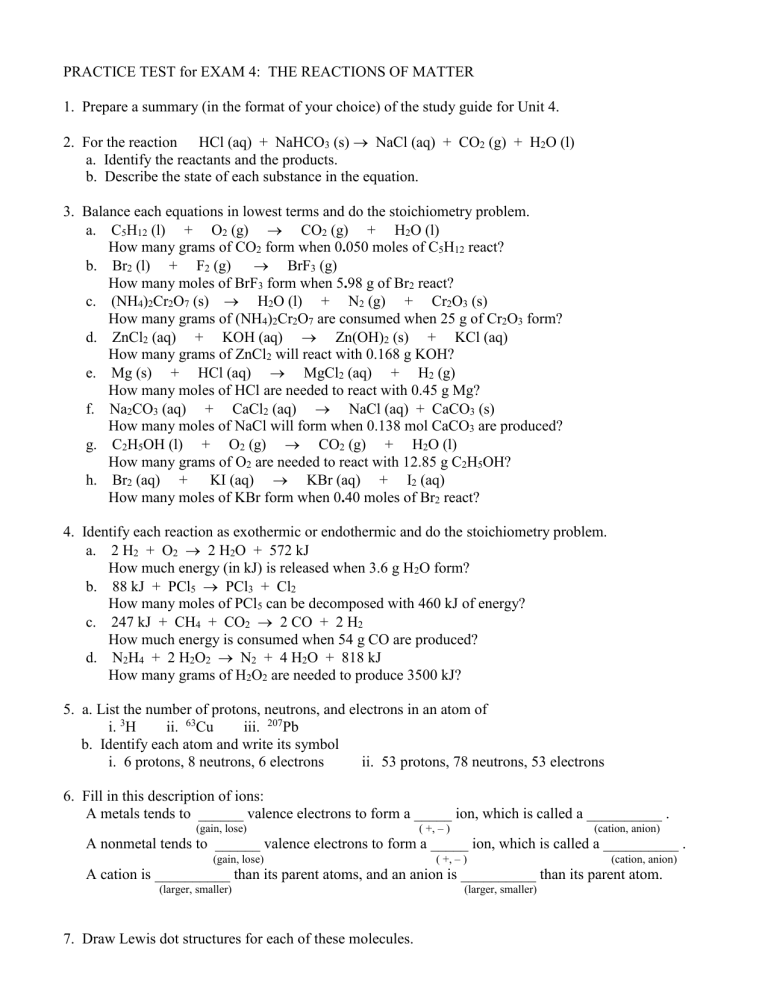
PRACTICE TEST for EXAM 4: THE REACTIONS OF MATTER
1. Prepare a summary (in the format of your choice) of the study guide for Unit 4.
2. For the reaction HCl (aq) + NaHCO
3
(s)
NaCl (aq) + CO
2
(g) + H
2
O (l) a. Identify the reactants and the products. b. Describe the state of each substance in the equation.
3. Balance each equations in lowest terms and do the stoichiometry problem. a. C
5
H
12
(l) + O
2
(g)
CO
2
(g) + H
2
O (l)
How many grams of CO
2
form when 0 .
050 moles of C
5
H
12
react? b. Br
2
(l) + F
2
(g)
BrF
3
(g)
How many moles of BrF
3
form when 5 .
98 g of Br
2
react? c. (NH
4
)
2
Cr
2
O
7
(s)
H
2
O (l) + N
2
(g) + Cr
2
O
3
(s)
How many grams of (NH
4
)
2
Cr
2
O
7
are consumed when 25 g of Cr
2
O
3
form? d. ZnCl
2
(aq) + KOH (aq)
Zn(OH)
2
(s) + KCl (aq)
How many grams of ZnCl
2
will react with 0.168 g KOH? e. Mg (s) + HCl (aq)
MgCl
2
(aq) + H
2
(g)
How many moles of HCl are needed to react with 0.45 g Mg? f. Na
2
CO
3
(aq) + CaCl
2
(aq)
NaCl (aq) + CaCO
3
(s)
How many moles of NaCl will form when 0.138 mol CaCO
3
are produced? g. C
2
H
5
OH (l) + O
2
(g)
CO
2
(g) + H
2
O (l)
How many grams of O
2
are needed to react with 12.85 g C
2
H
5
OH? h. Br
2
(aq) + KI (aq)
KBr (aq) + I
2
(aq)
How many moles of KBr form when 0 .
40 moles of Br
2
react?
4. Identify each reaction as exothermic or endothermic and do the stoichiometry problem. a. 2 H
2
+ O
2
2 H
2
O + 572 kJ
How much energy (in kJ) is released when 3.6 g H
2
O form? b. 88 kJ + PCl
5
PCl
3
+ Cl
2
How many moles of PCl
5
can be decomposed with 460 kJ of energy? c. 247 kJ + CH
4
+ CO
2
2 CO + 2 H
2
How much energy is consumed when 54 g CO are produced? d. N
2
H
4
+ 2 H
2
O
2
N
2
+ 4 H
2
O + 818 kJ
How many grams of H
2
O
2
are needed to produce 3500 kJ?
5. a. List the number of protons, neutrons, and electrons in an atom of i.
3
H ii.
63
Cu iii.
207
Pb b. Identify each atom and write its symbol i. 6 protons, 8 neutrons, 6 electrons ii. 53 protons, 78 neutrons, 53 electrons
6. Fill in this description of ions:
A metals tends to ______ valence electrons to form a _____ ion, which is called a __________ .
(gain, lose) ( +, – ) (cation, anion)
A nonmetal tends to ______ valence electrons to form a _____ ion, which is called a __________ .
(gain, lose) ( +, – ) (cation, anion)
A cation is __________ than its parent atoms, and an anion is __________ than its parent atom.
(larger, smaller) (larger, smaller)
7. Draw Lewis dot structures for each of these molecules.
a. CC l
4
b. C l O
2
1–
c. NO
2
1–
d. PH
3
e. CH
2
O
8. a. Compare/contrast the three major types of bonding: covalent, ionic, and metallic b. Identify the type of bonding in each of these substances: i. NH
3
ii. K
2
O iii. Fe iv. C
6
H
12
O
6
v. H
2
O vi. CuCl
2
vii. Au
9. On a blank periodic table, fill in the period numbers, group numbers, and staircase; label the alkali metal, alkaline earth, halogen, and noble gas families; indicate the nonmetal, semi-metal, metal, and transition metal regions; add the trends in atomic size and ionization energy.
Answers to UNIT 4 PRACTICE TEST
2. For the reaction HCl (aq) + NaHCO
3
(s)
NaCl (aq) + CO
2
(g) + H
2
O (l) a. The reactants are HCl and NaHCO
3
. The products are NaCl, CO
2
and H
2
O. b. NaHCO
3
is solid, H
2
O is liquid, CO
2
is a gas, and HCl and NaCl are aqueous (dissolved in water).
3. a. 1, 8, 5, 6 e. 1, 2, 1, 1 0.037 mol Mg b. 1, 3, 2 c. 1, 4, 1, 1
11 g CO
2
0 .
0748 mol BrF
3
41 g (NH
4
)
2
Cr
2
O
7 f. 1, 1, 2, 1 g. 1, 3, 2, 3
0.276 mol NaCl
26.78 g O
2 d. 1, 2, 1, 2 0 .
204 g ZnCl
2 h. 1, 2, 2, 1 0 .
80mol KBr
4. a. exothermic, 57 kJ b. endothermic, 5.2 mol c. endothermic, 238 kJ d. exothermic, 290 g
5. a. i. 1, 2, 1 ii. 29, 34, 29 iii. 82, 125, 82 b. i. 14 C ii. 131 I
6. A metal tends to lose valence electrons to form a positive ion, which is called a cation .
A nonmetal tends to gain valence electrons to form a negative ion, which is called an anion .
A cation is smaller than its parent atoms, and an anion is larger than its parent atom.
7. (Draw Lewis dot structures for each of these molecules.) See me for the dot structures. a. CC l
4
b. C l O
2
1–
c. NO
2
1–
d. PH
3
e. CH
2
O
8a. In covalent bonding, nonmetals share valence electrons with other nonmetals so that each atom is surrounded by 8 (or 2, for H). The atoms stay with their valence e
–
to form molecules. The molecule has no charge, so it does not conduct electricity in any state.
In ionic bonding, metals transfer e
–
to nonmetals; as a result, the metals form positive ions (cations) and the nonmetals form negative ions (anions), which stick together because of the attraction of their opposite charges. The ions collect into crystals but do not stay with their own electrons to form molecules. The ions can conduct electricity if they are free to move (liquid or dissolved in water).
In metallic bonding, metal atoms release their valence electrons, forming a lattice of positive ions in a
“sea” of mobile electrons that holds the metal cations together. The electrons are free to move, so metals conduct in both the solid and the liquid state.
8b. i. NH
3
covalent ii. K
2
O ionic iii. Fe metallic iv. C
6
H
12
O
6
covalent v. H
2
O covalent
vi. CuCl
2
ionic vii. Au metallic

